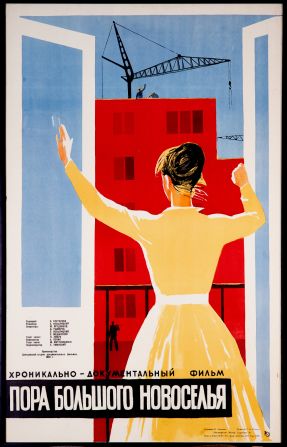
Poster for a 1959 Soviet documentary —
"It's Time for a Grand Housewarming," poster for a 1959 Soviet documentary on new urban reforms. The era of de-Stalinization in 1950s Soviet Russia was dominated by sweeping political reforms that put an end to forced labor and marked a split from the cult of personality that surrounded Stalin during his 30-year reign.
But there was a more subtle cultural shift too. A new, characterful style of design emerged -- typified by futuristic consumer goods like fridges, scooters and vacuum cleaners.
Fueled by a desire to match the quality of life enjoyed by their U.S. rivals, the then Soviet leader Nikita Khruschev built huge numbers of standardized apartment blocks or "Khrushchyovkas" across the USSR -- while Soviet designers raced to come up with goods to fill them.
Today these objects offer a colorful glimpse into daily life behind the Iron Curtain...
![<strong>Nevalyashka Dolls, from 1958</strong><br /><br />Fifty defining objects -- often beloved Eastern Bloc staples like this Nevalyashka roly-poly doll -- have been gathered together in a new exhibition at <a href="index.php?page=&url=http%3A%2F%2Fwww.grad-london.com" target="_blank" target="_blank">the Gallery for Russian Arts and Design</a> in London. "Work and Play Behind the Iron Curtain" explores the changes in Soviet design from the 1917 Revolution to Perestroika.<br /><br />Product design "really only emerged with Khruchshev's thaw," said gallery founder and exhibition co-curator Elea Sudakova. "Of course goods were made [before that], but aesthetically they really looked terrible...people didn't have toys, they had nothing around them."<br />](https://media.cnn.com/api/v1/images/stellar/prod/140702170955-nevalyashka-dolls-produced.jpg?q=w_4180,h_2789,x_0,y_0,c_fill/h_447)
Nevalyashka Dolls, produced from 1958 —
Nevalyashka Dolls, from 1958Fifty defining objects -- often beloved Eastern Bloc staples like this Nevalyashka roly-poly doll -- have been gathered together in a new exhibition at the Gallery for Russian Arts and Design in London. "Work and Play Behind the Iron Curtain" explores the changes in Soviet design from the 1917 Revolution to Perestroika.
Product design "really only emerged with Khruchshev's thaw," said gallery founder and exhibition co-curator Elea Sudakova. "Of course goods were made [before that], but aesthetically they really looked terrible...people didn't have toys, they had nothing around them."
![<strong>"Chaika" ("Seagull") Vacuum Cleaner, 1956</strong><br /><br />The idea of the space race was prevalent in the 1950s and many new designs, like this rocket-shaped vacuum cleaner, were purposefully built to echo the space-ship aesthetic.<br /> <br />"It was an attempt to show the benefits of this new technology to the population of the Soviet Union," said co-curator Alexandra Chiriac. "There was this idea that household appliances were like rockets for housewives."<br /> <br />"[The government] really tried to drive this point home, so that they wouldn't be accused of neglecting the population."](https://media.cnn.com/api/v1/images/stellar/prod/140702170609-chaika.jpg?q=w_5000,h_3334,x_0,y_0,c_fill/h_447)
Chaika Vacuum Cleaner, 1956 —
"Chaika" ("Seagull") Vacuum Cleaner, 1956The idea of the space race was prevalent in the 1950s and many new designs, like this rocket-shaped vacuum cleaner, were purposefully built to echo the space-ship aesthetic.
"It was an attempt to show the benefits of this new technology to the population of the Soviet Union," said co-curator Alexandra Chiriac. "There was this idea that household appliances were like rockets for housewives."
"[The government] really tried to drive this point home, so that they wouldn't be accused of neglecting the population."

'Saturnas' Vacuum Cleaner, produced from 1962 —
"Saturnas" Vacuum Cleaner, produced from 1962For many of those Soviets moving into the new standardized apartment blocks or "khrushchevkas," it was the first time they had access to electricity and running water.
Vacuum cleaners were a new technology and, said Chiriac, "people really wanted them" as "trophy objects."
Unfortunately, despite the concerted scramble to design and produce new consumer goods, demand too often outstripped supply and, says Chiriac, Soviets often complained that they simply couldn't get their hands on them.

ZIL Refrigerator, 1950s —
ZIL refrigerator, 1950sIn a move that was emblematic of the times, one of Soviet Russia's most prestigious industrial enterprises, the ZIL factory -- until then known for making cars, limousines and military vehicles -- started manufacturing refrigerators.
The ZIL refrigerator became ubiquitous in Soviet homes, although, said Sudakova, "at that time you would have to be very privileged to have your own kitchen, mostly they were communal.
"The fridge would be part of the living room ... to show that you owned it."

Soviet Music 'On the Bone' Vinyl Record —
Soviet Music 'On the Bone': Vinyl Record Copy on Medical X-Ray Fluorography Sheet, 1950s-1960sSoviet communal kitchens were a social space where "all kinds of free ideas were exchanged," said Sudakova. They were places where dissident ideas and underground culture flourished and where these bootleg copies of vinyl records featuring banned Russian and Western music might have been exchanged.
Cleverly made with illegally obtained x-ray sheets, they were popularly known as "musical bones" and used to illicitly distribute The Rolling Stones, Elvis, The Beatles and Russian chanson music up until the mid-1960s.

Vertushka Dial less Telephone —
"Vertushka" Dial-less TelephoneThis telephone is dial-less because there was only one number a Soviet caller using it could ring: The Kremlin. It would only have been found in the offices of high ranking military officials or big factory owners. When the caller reached the Kremlin, they would have automatically been directed to the person they wanted to talk to.
"So if you had one, in a way you were very proud of it, but also it meant you had to up your game," said Chiriac.
![<strong>"Vyatka" Scooter, produced from 1957 to 1966</strong><br /><br />Many early products were strikingly similar to Western designs, like this scooter that bears a striking similarity to the Italian Vespa.<br /><br />In the push for consumer goods, "[designers] didn't have the time to come up with new ideas," said Chiriac, so they traveled to the West and borrowed them.<br /><br />"It didn't really take off because it was too cold most of the time for people to use them, so it was a good example of a Western idea implemented without thinking of the local specifics."](https://media.cnn.com/api/v1/images/stellar/prod/140702171359-vyatka-scooter-produced.jpg?q=w_4262,h_2843,x_0,y_0,c_fill/h_447)
'Vyatka' Scooter, produced from 1957 to 1966 —
"Vyatka" Scooter, produced from 1957 to 1966Many early products were strikingly similar to Western designs, like this scooter that bears a striking similarity to the Italian Vespa.
In the push for consumer goods, "[designers] didn't have the time to come up with new ideas," said Chiriac, so they traveled to the West and borrowed them.
"It didn't really take off because it was too cold most of the time for people to use them, so it was a good example of a Western idea implemented without thinking of the local specifics."


